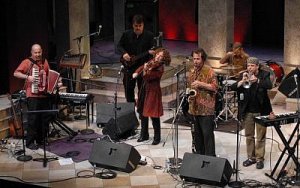Yidstock: The Festival of New Yiddish Music, running in Amherst, focuses on klezmer tradition – and innovationWoodstock 1969, meet Yidstock 2012.
Back in the day, the Woodstock Music and Arts Fair in Bethel, New York, may have featured such acts as Jimi Hendrix, Jefferson Airplane and the Grateful Dead, but today’s Yidstock: The Festival of New Yiddish Music, running July 11-15 in Amherst, Massachusetts, will present a who’s who of musicians from the klezmer and Yiddish music worlds, on the grounds of the National Yiddish Book Center.
“The idea behind the festival is to build on what the Yiddish Book Center has been doing and take it to a whole new level — to program a festival of contemporary Yiddish and klezmer music that draws upon both tradition and innovation,’says festival programmer, Seth Rogovoy, music critic and author “The Essential Klezmer: A Music Lover’s Guide to Jewish Roots and Soul Music” and “Bob Dylan: Prophet, Mystic, Poet.”
Priceless Yiddish books that had survived Hitler and Stalin were being discarded and destroyed
The Yiddish Book Center grew out of the work of Aaron Lansky, a 24-year-old graduate student in Yiddish literature who, in 1980, learned that thousands of priceless Yiddish books that had survived Hitler and Stalin were being discarded and destroyed. American-born Jews were unable to read the language once spoken by their parents and grandparents. Lansky organized a national network of zamlers, volunteer book collectors, to save the world’s remaining Yiddish books.
“We weren’t collecting books for too long before we realized it was just the tip of the iceberg,” recounts Lansky, the founder and president of the Yiddish Book Center and the editor of its magazine, PaknTreger. “We didn’t just lose books, but we lost the constellation of Jewish life — language, literature, music, film and theater.”
The Yiddish Book Center has helped ensure the preservation and rebirth of Yiddish language and culture. The 49,000 square foot center is home to more than 1,500,000 volumes of Yiddish books. More than 11,000 Yiddish titles are now available free of charge online through the Center’s Steven Spielberg Digital Yiddish Library, and undergraduate students interested in becoming the next generation of Yiddish language speakers and translators spend their summer learning Yiddish language, culture and history.
‘Through the course of the festival you get a picture of where the music has been, where it is now, and where it is headed’
Yidstock, a more popular front of the center’s activities, will feature such top names in klezmer and Yiddish music as Hankus Netsky and the Hebrew National Salvage, Grammy Award winners the Klezmatics, Josh Dolgin aka “Socalled,” Frank London’s Klezmer Brass Allstars with Eleanor Reissa, and the Michael Winograd Trio. Yidstock will also include a film festival, a klezmer instrumental workshop and a klezmer brunch. Rogovoy will deliver a talk entitled “Rockin’ the Shtetl: The Essential Klezmer.”
“Through the course of the festival,” notes Rogovoy, “you get a picture of where the music has been, where it is now, and where it is headed.”
Hankus Netsky, scion of a klezmer dynasty, one of the original klezmer revivalists, and founder of the Klezmer Conservatory Band, shares Rogovoy’s appreciation for the Yiddish Book Center.
“The Yiddish Book Center exists because the mainstream world neglected, then discarded, Yiddish literature and everything else too. The revival and revitalization is a major triumph of the last 30 years — this festival celebrates that.” Netsky, who holds a PhD in ethnomusicology and is director of the Itzhak Perlman “Eternal Echoes: Songs and Dances for the Soul” Project (to be released in the Fall of 2012 on Sony), speaks passionately about the themes of “salvage,” rescue and revitalization (he will be performing with a group known as Hebrew National Salvage).

“We found Jewish culture discarded in the dumpster and are doing what Jewish business people have always done — we are finding a new use for it. My father was in the rag business so I am familiar! We are putting it back into circulation. We are reclaiming it.”
Netsky refers to his work as “salvage ethnography.”
He adds, “Jewish music is the same as Jewish literature — it builds on what came before it and is eminently creative.”
Netsky relates that the entry for klezmer in the 1975 Dictionary of Jewish Music read, “The klezmer tradition died out in the 19th century.”
“Huh?” asks Netsky, “That’s interesting! All my grandfathers and uncles were klezmer musicians!”
In a summer, 2011, PaknTreger article entitled, “But Is It Klezmer?” Rogovoy explores this latest wave of Jewish music, which continues to borrow from many sources. He playfully reports on the types of comments he hears when he exits concerts by performers like the ones who will play at Yidstock.
‘Klezmer has always spoken in the idiom of its time. And that time is now, and the fusion of hip-hop, funk, and jazz is our musical currency’
“If I had a dollar for every time I hear someone saying ‘I don’t know what you call that, but that’s not klezmer,’ I’d be, as the saying goes, a rich man,” says Rogovoy. “I hate to disappoint you, but yes, it is klezmer. And not only is it klezmer, it is part and parcel of the klezmer tradition. Indeed, it is traditional klezmer, because klezmer has always spoken in the idiom of its time. And that time is now, and the fusion of hip-hop, funk, and jazz is our musical currency.”
(Source: http://www.timesofisrael.com)
